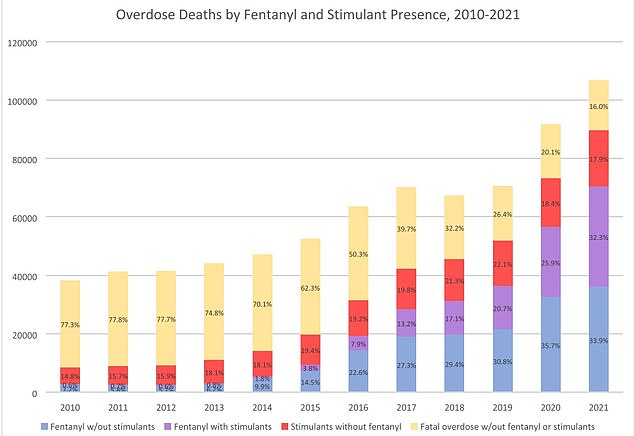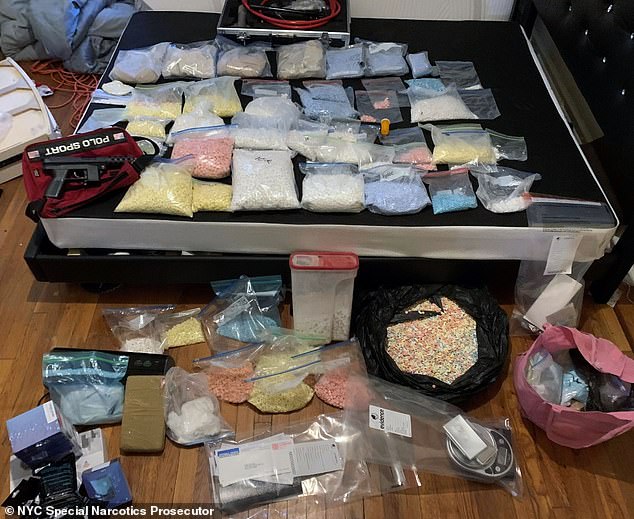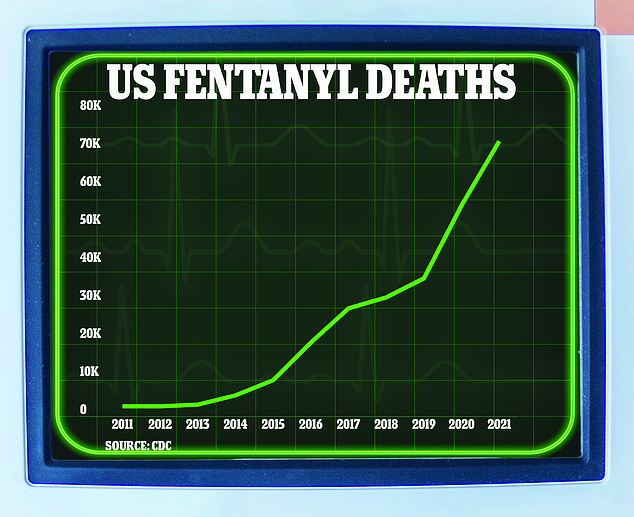Overdose deaths from cocaine and meth containing fentanyl have increased 50-fold since 2010
Overdoses caused by the combination of fentanyl and stimulants, including cocaine and meth, have increased fiftyfold in just over a decade.
The number of fentanyl overdoses that also involve powerful stimulants has risen so rapidly over the years that addiction experts are calling it the “fourth wave” of the devastating opioid crisis still gripping the US.
Researchers reported that the proportion of drug overdoses involving both fentanyl and a stimulant increased from less than one percent in 2010 to nearly a third in 2021.
Further exacerbating the tragedy, many users unknowingly consume fentanyl — tiny doses of which are enough to kill — because it is often used as a cutting agent in cocaine and other illicit drugs to increase supply and the high.
Naloxone has proven to be a gamechanger for reversing opioid overdoses, saving thousands of lives. However, the antidote does nothing to reverse overdoses of other drugs, leaving first responders without an effective stopgap solution.
After the first wave, fueled by prescription opioids, came the second wave, driven by a shift to heroin, followed by the third wave, driven by an explosion in fentanyl demand and supply. This “fourth wave” of the opioid addiction epidemic began in earnest in 2015

In the graph above, the height of each bar shows the total number of drug overdose deaths that year. While overdose deaths in the United States rose from 38,329 in 2010 to 106,699 in 2021, the percentage involving both fentanyl and stimulants rose from 0.6 percent to 32.3 percent

In May of last year, Mac Miller’s drug supplier was sentenced to more than 17 years in prison for distributing counterfeit oxycodone laced with fentanyl, which, when combined with cocaine use, caused the rapper’s fatal overdose in 2018.
As overdose deaths rose from about 38,000 in 2010 to more than 106,000 in 2021, the number of overdoses involving fentanyl in addition to a stimulant increased.
The percentage of overdose deaths in the US involving both fentanyl and stimulants has increased from 0.6 percent (235 overdoses) in 2010 to approximately 32 percent (34,429 overdoses) in 2021, with the steepest increase beginning in 2015.
The researchers sifted through a mountain of death data from the Centers for Disease Control and Prevention’s Wide-Ranging Online Database for Epidemiological Research (WONDER) from 2010 to 2021.
They were then able to measure annual rates of overdoses from fentanyl alone, stimulants alone, fentanyl and stimulants combined, and non-fentanyl or stimulant medications.
During this period, fentanyl overdoses without any additional stimulant also skyrocketed from just over seven percent in 2010 to nearly 36 percent eleven years later.
However, stimulant-only overdoses remained relatively stable, from almost 15 percent in 2010 to just under 18 percent in 2021.
This “fourth wave” of the opioid addiction epidemic, which began in the late 1990s with the advent of extremely powerful prescription pills like OxyContin, only really took off in 2015, about two years after fentanyl overtook heroin as the deadliest opioid on the streets. .
After the first wave, fueled by prescription opioids, came the second wave, driven by a shift to heroin, followed by the third wave, driven by an explosion in fentanyl demand and supply.
Dr. Joseph Friedman, an addiction researcher at UCLA’s David Geffen School of Medicine, said: ‘Fentanyl has ushered in an overdose crisis, meaning people are mixing fentanyl with other drugs, such as stimulants, as well as countless other synthetic substances. This poses many health risks and new challenges for healthcare providers.
“We have data and medical expertise on treating opioid use disorder, but relatively little experience with combining opioids and stimulants together, or opioids mixed with other medications.”

Fentanyl-related deaths in the US have skyrocketed in the 2010s. At the start of the decade, 2,666 Americans died from a fentanyl overdose. This figure shot up to 19,413 in 2016. Covid made the situation even worse, with a record 72,484 deaths in 2021

Fentanyl-related deaths in the US have skyrocketed in the 2010s. At the start of the decade, 2,666 Americans died from a fentanyl overdose. This figure shot up to 19,413 in 2016. Covid made the situation even worse, with a record 72,484 deaths in 2021
After researching the matter closely, Dr. Friedman and fellow researchers who authored the study found that the top stimulant combined with fentanyl in the Southern and Western states was methamphetamine, while cocaine was the preferred combination in the Northeastern states.
In 2021, fentanyl overdoses involving meth were most common in Western states, including Alaska, California, Hawaii, New Mexico, Oregon and Washington, as well as West Virginia and Kentucky.
Meanwhile, in much of the northeastern states, such as Rhode Island, Vermont and Massachusetts, cocaine was the most common stimulant.
Dr. Friedman said: “We suspect that this pattern reflects the increasing availability and preference for cheap, high-purity methamphetamine in the US, and the fact that the Northeast has a well-entrenched pattern of illicit cocaine use that is so resistant to full takeover by methamphetamine seen elsewhere in the country.”
The emergence of polysubstance overdoses is not tracked in the same way as overdoses attributed solely to fentanyl, because the U.S. drug surveillance system is limited in the amount of data it can collect on poisonings involving more than just one drug.
Researchers also warned of the rise of sinister counterfeit pills disguised as drugs sold on the street, including Percocet and Xanax.
Many people discover too late that their medications were loaded with fentanyl, which can be fatal in infinitesimally small doses — think an amount that fits on the tip of a pencil.
They said: ‘In recent years, counterfeit pills have grown to account for more than a quarter of all illicit fentanyl seizures.
“Counterfeit pills have the potential to transform overdose risk by expanding the market for illicit synthetic drugs to subpopulations, such as adolescents, who are less likely to consume fentanyl powder products.”
This is not a new problem. In 2018, rapper Mac Miller died after an accidental overdose resulting from a fatal combination of cocaine with pills that dealers who sold him claimed were oxycodone and Xanax. The pills were actually pressed with fentanyl, enough to kill the young rapper at just 26 years old.
The study by UCLA researchers was published in the journal on Wednesday Addiction.
